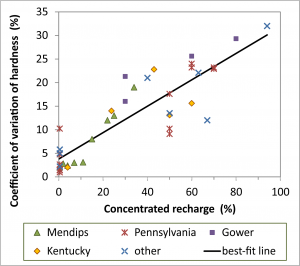There is an extensive literature on karst springs, most of it focusing on large springs in limestone aquifers. Such springs have been important for water supplies for thousands of years. From the earliest hydrogeological studies it has been widely recognized that these springs discharge from networks of channels, as described in this paper.

The chemistry of some carbonate springs varies substantially over time, while other springs in the same aquifer may only vary a little. It has been found that the variation of total hardness is proportional to the fraction of concentrated recharge to an aquifer through sinking streams and dolines, as shown in the figure. This is logical, because concentrated recharge and subsequent rapid flow through channels to springs will result in little attenuation of the input signal, while percolation recharge through the soil results in dampening of the input signal, as shown in this paper.